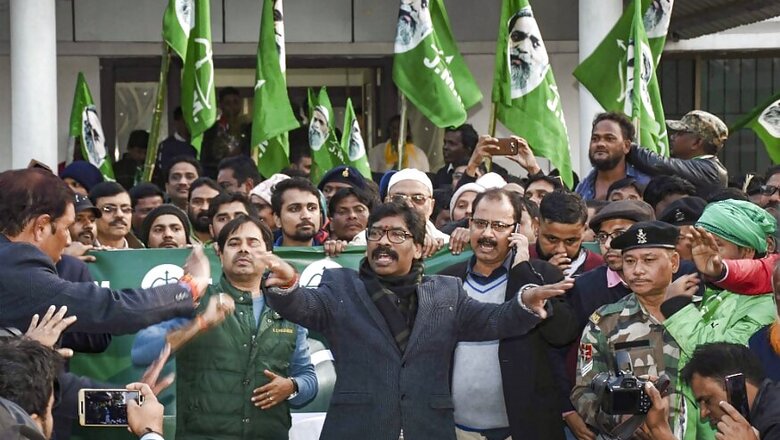
views
The main market in Patan bore a forlorn look. Ravi Chou-mein Centre on Daltonganj Road, however, was doing brisk business despite a power cut in the locality. Across the street, a small group of poll ticket aspirants, including one Ranjit Singh Chintu and audience, waited for Jharkhand Mukti Morcha chief Hemant Soren. Soren was running behind schedule on the second day of his Palamu Yatra.
That was exactly 11 months back to this day, when Soren kicked off his election campaign in Palamu division of Jharkhand bordering Bihar. It is also the area where Jharkhand Mukti Morcha has always found the going tough. Palamu, one of the most backward and drought-prone districts, has never been a JMM turf where non-tribal vote far outnumbers the JMM core constituency. Soren’s party never won even one assembly seat in this division.
This limited footprint – both in terms of core constituency and area – has always been the biggest challenge before the party which under Hemant's father Shibu Soren led the movement for the creation of a separate tribal state comprising what was then the southern half of Bihar. That campaign of three decades and more came to fruition in the year 2000 when Jharkhand was created by the Atal Bihari Vajpayee government, along with Uttarakhand and Chhattisgarh.
And in all these years, even in the worst of times, when the odds were against it, the JMM had managed to win seats on its turf in tribal districts. In Santhal Pargana, where Soren comes from. And in the Kolhan belt around Jamshedpur.
In other regions like Chota Nagpur plateau and urban areas, the JMM had little support base. The Jharkhand movement had been prompted by the exploitation of tribals by the outsiders or the ‘dikkus’. The upper caste and the urban voter in particular were the class enemy against which JMM had mobilised its people. This segment, even after the creation of the state, thus remained out of the catchment area of the JMM.
And so, the party which was credited with the creation of the state could never really muster numbers to form a government on its own strength. Out of the 81 seats in the state assembly, its area of influence has been limited to about 45.
In 2018, ahead of launching his yatra, Soren in a meeting with UPA leaders chaired by Sonia Gandhi surprised many by seeking early resolution of seat-sharing negotiations for the Lok Sabha polls. But his aim was directed more towards seeking a clear and categorical public assurance from the Congress in accepting Soren's leadership in the 2019 assembly polls in Jharkhand. Against this, the JMM conceded a large chunk of seats in the parliamentary polls to the Congress.
The JMM's alliance with the Congress, RJD and JVM lost badly to the BJP in the general elections. But Soren's campaign all along had been aimed at softening anti-JMM voters in the urban and upper caste dominated seats where the Congress and RJD would take on rival BJP. His backroom strategising was aided by a team consisting of public policy, communication and consultation specialists who studied at universities like Oxford, Sussex, Essex as well as TISS, etc. The focus was on in-depth mapping of issues, filed analysis, 360-degree communication and strengthening organisational capacity. Soren was packaged as an underdog public figure, who could bring the challenges of the marginalised and distressed sections of society into the mainstream narrative.
The strategy was akin to what Mayawati did in Uttar Pradesh in 2007. Build a larger social coalition around the core dalit vote. Soren this time around was able to make his party and his allies more acceptable to the BJP voter. Especially the allies- Congress and RJD who would challenge the BJP in urban and non-tribal seats.
The effect this time is telling. The RJD has put up a very creditable performance after contesting on seven seats in districts bordering Bihar. The Congress has managed to retain its seats in urban centres and the Kolhan region.
Soren carried out about 165 rallies across the state over 28 days, covering each constituency at least twice. Also, numerous backchannel meetings were organised with civil society groups, activists, government employees’ associations, etc.
It was the worst kept secret in this election that the JMM was helping the BJP's renegade minister Saryu Rai who defeated chief minister Raghubar Das in Jamshedpur. Rai returned the gesture in the last phase of polling, as he went to Dumka to campaign for the JMM.
After a crushing Lok Sabha defeat, the opposition in Jharkhand relied on two recent trends in Indian politics. That people now tend to vote differently in parliamentary and assembly polls. And the anti-incumbency of the local leadership does swing an election outcome. As it happened in Rajasthan last December. So it has happened in Jharkhand.
















Comments
0 comment